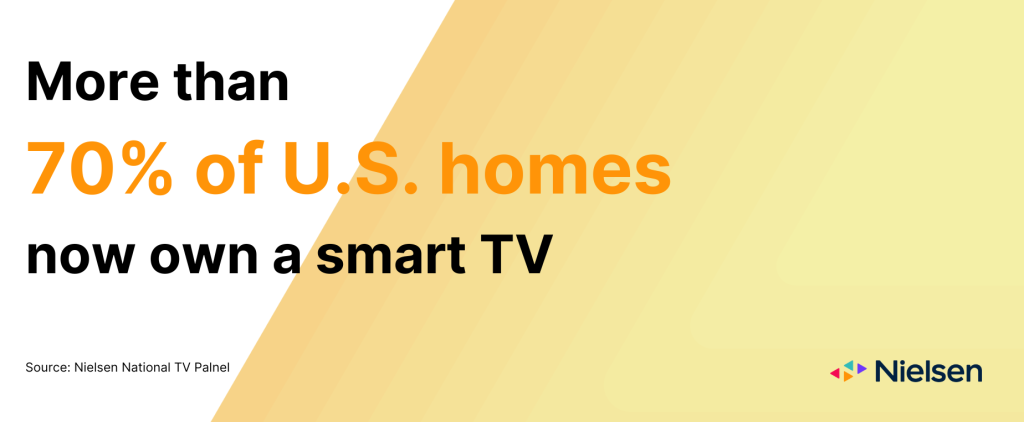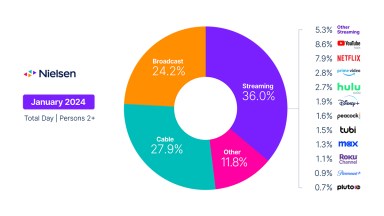Today’s TV landscape offers more than a lifetime’s worth of choice for audiences. In total, TV audiences in the U.S. can now find content on more than 32,200 linear channels and 89 streaming video sources1. Additionally, connected TV (CTV)2 has given audiences access to anything the internet has to offer.
The appeal of content audiences can access through an internet connection is undeniable. Streaming programming, enabled by CTV, has accounted for more than one-third of total TV usage in the U.S. since February 2023 and more than 36% since May 20233.
All this wealth of choice—and audiences’ gravitation to it—has introduced new considerations for media planning that didn’t exist a decade ago. And marketers in North America are keeping pace by adjusting their spending accordingly, shifting 45% of their ad budgets to CTV in 20234. The downside, however, is that 40% say that CTV measurement remains a challenge.
While the TV screen has evolved into a conduit that can display content from a growing range of sources, the basics of measurement still apply: When you know who’s engaged, you have the insight you need to engage with them.
Importantly, the explosion of choice has not inspired an increase in total TV usage. It’s simply caused audiences to view content across a wider range of sources. The average U.S. adult spends about 32 hours each week with TV during warmer months and an additional two or three when the weather gets colder. As consistent as total TV usage is, however, the portion dedicated to content accessed via CTV continues to grow.
In the last year alone, U.S. audiences 18 and older increased the time they spent with content they access through their connected devices by more than 20% to account for just under 40% of total TV usage. Among younger audiences, CTV usage is far more dominant: 80.2% among 12-17-year-olds; 73.6% among 21-34-year-olds; 56.8% among 25-54-year-olds.
The increasing engagement is very much correlated with growing access. Today, TV connected devices reach 75% of people 2 and older5. That’s up from just 58% at the start of 2020. The penetration of smart TVs6, which often come with pre-installed apps that provide direct access to streaming content, is also nearing ubiquity: smart TV penetration is now 70.6% among U.S. TV homes5.

While connectivity opens the doors to any content the internet has to offer, streaming video is the leading driver behind the growing adoption of TV connected devices. Those devices provide audiences with access to far more content than what’s available on traditional, linear TV channels. As of October 2023, streaming services were home to just over 85% of the more than 1.1 million unique video titles available to U.S. audiences. That’s up from approximately 656,000 titles at the start of 20201.
That depth of variety, coupled with the expanding streaming landscape and the on-demand nature of many streaming services, has given streaming the edge with respect to TV usage. When Nielsen launched the Gauge in May 2021, only five streaming services accounted for more than 1% of total TV usage—the benchmark to be measured independently on a monthly basis. In November 2023, 11 services were individually reported in the Gauge.
In addition to streaming’s dominant share of TV, time spent with streaming video highlights the gravitational pull of the expanding wealth of available content. For context, U.S. audiences spent just under 15 billion hours watching the top 10 most-watched original, acquired7 and movie titles during the week of Nov. 13, 2023.
Wide CTV adoption, device proliferation, new acronyms and an abundance of streaming services have added to the complexity of media planning by obfuscating the actual behavior. Virtual multichannel video programming distributors (vMVPDs), for example, have become popular alternatives to traditional cable packages, growing to account for a record high 5.7% of total TV usage in September 2023. But media planning is contingent on what’s being watched, not how content is accessed.
Through the lens of total TV usage, regardless of access point, the keys to media planning only involve answering two questions:
- Who’s watching
- What they’re watching
On the surface, the fragmented nature of where content comes from can present itself as a significant media planning challenge. But when advertisers and agencies hone their focus to understanding time spent with broadcast, cable and streaming content, they have the foundational data they need for effective and efficient media planning.
To learn more audience and programming insights critical for the 2024 Upfronts/NewFronts planning season, read our full guide.
Notes
1Gracenote Global Video Data; October 2023
2CTV refers to any television that accesses content from the internet. The most common use case is to stream video content.
4Nielsen 2023 Annual Marketing Report
5Nielsen National TV Panel; Q2 2023
6A smart TV is television with the built-in capability to access the internet
7Acquired titles are those that have been licensed from other content owners after first airing somewhere else. For example, audiences can find S.W.A.T., a CBS original, on Hulu, Netflix and Paramount+.



